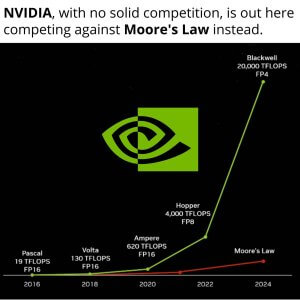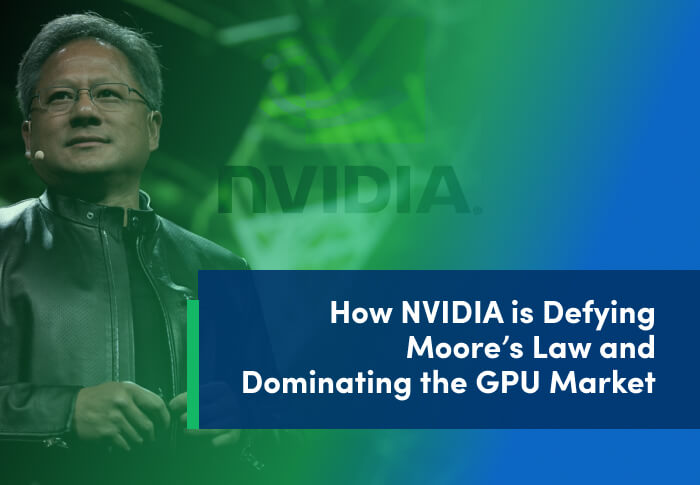In the fast-paced world of technology, few ideas have been as impactful as Moore’s Law. First put forward by Intel co-founder Gordon Moore in 1965, this principle predicted that the number of transistors on a microchip would double about every two years, resulting in rapid advancements in computing power. Yet, when we turn our attention to graphics processing units (GPUs), we see that NVIDIA, a leading force in the industry, is not merely following Moore’s Law but surpassing it in significant ways.

The Moore’s Law Conundrum:
Moore’s Law has long been considered a yardstick for technological progress, but its applicability to GPU performance is often debated. While the law primarily focuses on transistor density, not performance per se, it serves as a benchmark for gauging computational improvement. However, when it comes to GPUs, traditional Moore’s Law projections fall short in capturing the full scope of advancement.
According to data from Jon Peddie Research, the compound annual growth rate (CAGR) of GPU shipments between 2015 and 2020 was 9.8%, outpacing the 7.4% CAGR of Moore’s Law during the same period. This discrepancy underscores the accelerated pace of GPU innovation relative to traditional expectations.
NVIDIA’s Architectural Innovations:
One of the key reasons behind NVIDIA’s divergence from Moore’s Law lies in its relentless pursuit of architectural optimizations. By harnessing cutting-edge design principles and leveraging specialized processing units, NVIDIA has consistently pushed the boundaries of GPU performance. This strategic focus on innovation has enabled the company to outpace the trajectory dictated by Moore’s Law.
Case Study: The introduction of NVIDIA’s Turing architecture marked a significant milestone in GPU evolution. With features such as real-time ray tracing and AI-enhanced graphics, Turing-based GPUs deliver unprecedented levels of realism and immersion in gaming and professional visualization applications.
GPU Performance vs. Moore’s Law:
A closer examination of GPU performance reveals a fascinating trend: while Moore’s Law may serve as a reference point, NVIDIA’s GPUs consistently surpass its projections. This phenomenon can be attributed to a myriad of factors, including advancements in parallel processing, efficient memory management, and the integration of AI-driven technologies like deep learning.
According to benchmarks conducted by TechSpot, NVIDIA’s latest Ampere architecture boasts a performance improvement of up to 70% compared to the previous generation, far exceeding the pace predicted by Moore’s Law.
Jensen Huang: The Architect of NVIDIA’s Success:
At the helm of NVIDIA’s groundbreaking initiatives stands Jensen Huang, a visionary leader who has become synonymous with innovation in the GPU industry. With his bold approach to technology and a penchant for rewriting the rules, Huang has effectively crafted NVIDIA’s own version of “Huang’s Law,” wherein the company continually outpaces conventional expectations.
Case Study: During his keynote address at NVIDIA’s GPU Technology Conference (GTC), Jensen Huang unveiled the company’s latest breakthroughs in AI and accelerated computing. Demonstrations showcasing real-time AI inference and data analytics underscored NVIDIA’s commitment to driving innovation across diverse industries.
Consumer Adoption and Impact:
NVIDIA’s advancements in GPU technology have reverberated across various sectors, leaving a profound impact on consumers worldwide. Here are some examples illustrating how NVIDIA’s innovations have transformed consumer experiences:
- Enhanced Gaming Experiences: Gaming enthusiasts have been among the primary beneficiaries of NVIDIA’s GPU advancements. With each new generation of GPUs, gamers experience a leap in graphical fidelity, realism, and performance. NVIDIA’s RTX series, powered by ray tracing technology, has revolutionized gaming visuals by delivering lifelike lighting, shadows, and reflections in real-time.
- Productivity in Creative Industries: Beyond gaming, NVIDIA GPUs have become indispensable tools in creative industries such as animation, film production, and graphic design. Professionals rely on NVIDIA’s CUDA cores and specialized rendering capabilities to accelerate rendering times, streamline workflows, and unleash their creative potential.
- Advancements in Scientific Research and Healthcare: In scientific research and healthcare, NVIDIA GPUs play a pivotal role in accelerating computational tasks and driving groundbreaking discoveries. Researchers harness the parallel processing power of GPUs to accelerate simulations, analyze vast datasets, and unravel complex scientific phenomena.
Leveraging NVIDIA Graphics for Superior Performance:
For businesses and individuals seeking to harness the power of cutting-edge visual computing, NVIDIA offers a formidable array of GPUs, including the robust RTX 6000 series. These GPUs not only deliver unparalleled graphics performance but also excel in data processing tasks, making them indispensable tools for industries ranging from gaming to scientific research.
Case Study: In the field of medical imaging, researchers at the Mayo Clinic leveraged NVIDIA’s GPUs to accelerate the processing of MRI scans, reducing analysis time from hours to minutes. This acceleration enabled healthcare professionals to diagnose and treat patients more efficiently, leading to improved patient outcomes.
Unveiling the Potential of GPU Servers:
Discover the capabilities of Netrouting’s GPU servers in the NVIDIA ecosystem. Built with NVIDIA technology, our servers are ideal for demanding applications in artificial intelligence, machine learning, and data analytics. Explore how our scalable, efficient solutions can meet your evolving infrastructure requirements.
Integrating Netrouting’s GPU Servers:
Are you ready to elevate your computing capabilities to unprecedented heights? Look no further than Netrouting‘s GPU servers.
– Powerful Performance: Our GPU servers are engineered to deliver unparalleled performance, leveraging the immense processing power of graphics processing units (GPUs) to tackle the most demanding workloads with ease.
– Scalability and Flexibility: Whether you’re a startup looking to scale your operations or an enterprise in need of robust computing resources, our GPU servers offer the scalability and flexibility to meet your evolving needs.
– Accelerated Workloads: Say goodbye to sluggish performance and hello to accelerated workloads. With our GPU servers, tasks that once took hours can now be completed in minutes, empowering you to achieve more in less time.
– Optimized for AI and Machine Learning: In the era of artificial intelligence and machine learning, having access to powerful computing resources is essential. Our GPU servers are optimized to handle complex AI and ML algorithms, enabling you to unlock new insights and drive innovation.
– Reliable Infrastructure: At Netrouting, we understand the importance of reliability and uptime. That’s why our GPU servers are hosted in state-of-the-art data centers with redundant power and connectivity, ensuring maximum availability for your critical workloads.
– Expert Support: Need assistance or technical guidance? Our team of experts is here to help. From deployment and configuration to troubleshooting and optimization, we’re dedicated to providing top-notch support every step of the way.
Visit Netrouting today to learn more and embark on your journey towards next-generation computing.
Market Trends and Future Outlook:
As we look to the future of GPU technology, several emerging trends are poised to shape the industry landscape. Quantum computing, with its potential to revolutionize computation by harnessing the principles of quantum mechanics, holds promise for unlocking new frontiers in GPU development. Similarly, neuromorphic engineering, inspired by the human brain’s architecture, offers novel approaches to designing energy-efficient and highly parallel computing systems. By embracing these emerging technologies, NVIDIA and its counterparts are poised to drive the next wave of innovation in GPU computing, paving the way for transformative advancements in artificial intelligence, scientific research, and beyond.
Conclusion:
As we navigate the intricate landscape of technological progress, NVIDIA stands as a testament to the boundless potential of innovation. By defying the constraints of Moore’s Law and charting its own trajectory, NVIDIA continues to reshape the future of visual computing. Whether through groundbreaking GPU architectures or cutting-edge server solutions, the company remains at the forefront of technological advancement, paving the way for a new era of computational excellence.






